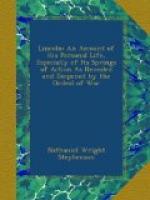But all this elaborate reasoning, if it went no further, lacked authority. It was political speculation. To clothe itself with authority it had to discover a foundation in historic fact. The real difficulty was not what ought to have been established in America in the past, but what actually had been. Where was the warrant for those bold proposition—who “we, the people,” really were; in what their sovereign power really consisted; what was history’s voice in the matter? To state an historic foundation was the final aim of the message. To hit its mark it had to silence those Northerners who denied the obligation to fight for the Union; it had to oppose their “free love” ideas of political unity with the conception of an established historic government, one which could not be overthrown except through the nihilistic process of revolution. So much has been written upon the exact location of sovereignty in the American federal State that it is difficult to escape the legalistic attitude, and to treat the matter purely as history. So various, so conflicting, and at times so tenuous, are the theories, that a flippant person might be forgiven did he turn from the whole discussion saying impatiently it was blind man’s buff. But on one thing, at least, we must all agree. Once there was a king over this country, and now there is no king. Once the British Crown was the sovereign, and now the Crown has receded into the distance beyond the deep blue sea. When the Crown renounced its sovereignty in America, what became of it? Did it break into fragments and pass peacemeal to the various revolted colonies? Was it transferred somehow to the group collectively? These are the obvious theories; but there are others. And the others give rise to subtler speculations. Who was it that did the actual revolting against the Crown—colonies, parties, individuals, the whole American people, who?




